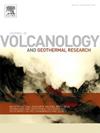东爪哇Ranu Grati Maar的岩相和幼年碎屑变化:对单成因火山喷发转变的见解
IF 2.3
3区 地球科学
Q2 GEOSCIENCES, MULTIDISCIPLINARY
Journal of Volcanology and Geothermal Research
Pub Date : 2025-08-10
DOI:10.1016/j.jvolgeores.2025.108426
引用次数: 0
摘要
Maar-diatremes是了解喷气喷发动力学和相关危害的宝贵档案。它们的地层记录往往保存了复杂的喷发风格和对喷发前岩浆条件的洞见。在本研究中,我们将详细的岩相分析与印度尼西亚东爪哇Ranu Grati Maar火山碎屑矿床的岩石学和地球化学调查相结合,重建了喷发过渡和喷发前的岩浆条件。沿着火山口南部和东部边缘暴露的~ 15 m厚的火山层序揭示了四个不同的地层单元(单元1-4),通过粒度、成分和沉积特征的变化来区分。这些单位记录了火山喷发期间的喷发方式在火山喷发和岩浆喷发之间的振荡。三种幼年火山碎屑,每一种都是红褐色的(黑色、灰色和金色),根据质地和颜色的差异进行了识别。岩石学和地球化学数据表明,这些矿渣类型具有相似的体积组成和矿物组合,但表现出明显的结构差异,包括微石含量(黑色矿渣为~ 16.3%,灰色和金色矿渣为~ 9.1 - 9.6%)、微石数量密度和囊泡性(黑色矿渣为~ 55.5%,灰色和金色矿渣为~ 69.7 - 71.5%)。这些差异表明,黑色矿渣在较冷的管道边缘停留的时间更长,有利于微岩结晶和脱气的增强,而灰色和金色矿渣在较热的管道中心区域经历了更快的上升和持续的泡化。尽管结构多样,但其地球化学分异最小,表明其可能起源于单一岩浆批次,其非均质性受动态管道过程驱动,而非复杂岩浆演化。该研究表明,在Ranu Grati Maar等单成因系统中,喷发转变和振荡喷发风格可以由浅层岩浆过程(包括气泡生长、冷却和结晶)控制,而不需要新的岩浆输入、含水层波动或长期的岩室演化等外部触发因素。这突出了火山碎屑的结构监测对于解释喷发条件和改进危害评估的重要性,特别是在短期喷发可能表现出爆炸性突然变化的单成因火山领域。本文章由计算机程序翻译,如有差异,请以英文原文为准。
Lithofacies and juvenile clast variations at Ranu Grati Maar, East Java: Insights into eruptive transitions in monogenetic volcanoes
Maar-diatremes are valuable archives for understanding phreatomagmatic eruption dynamics and associated hazards. Their stratigraphic records often preserve complex eruptive styles and insights into magmatic conditions prior to eruption. In this study, we integrate detailed lithofacies analysis with petrographic and geochemical investigations of pyroclastic deposits from Ranu Grati Maar, East Java, Indonesia, to reconstruct eruptive transitions and pre-eruptive magmatic conditions. A ∼ 15 m thick tephra succession exposed along the southern and eastern crater rims reveals four distinct stratigraphic units (Units 1–4), differentiated by variations in grain size, componentry, and depositional features. These units record oscillations between phreatomagmatic and magmatic eruptive styles during the eruption. Three juvenile pyroclasts, each scoriaceous (black, gray, and golden), are identified based on textural and color differences. Petrographic and geochemical data indicate that these scoria types share similar bulk compositions and mineral assemblages but display distinct textural variations, including microlite content (∼16.3 % in black scoria vs. ∼9.1–9.6 % in gray and golden scoria), microlite number density, and vesicularity (∼55.5 % in black scoria vs. ∼69.7–71.5 % in gray and golden scoria). These differences suggest that black scoria resided longer in cooler conduit margins, allowing for enhanced microlite crystallization and degassing, whereas gray and golden scoria experienced more rapid ascent and sustained vesiculation in the hotter central conduit zone. Despite their textural diversity, the juvenile clasts from Ranu Grati show minimal geochemical differentiation, indicating that they likely originated from a single magma batch, with heterogeneity driven by dynamic conduit processes rather than complex magmatic evolution. This study demonstrates that eruptive transitions and oscillatory eruption styles in monogenetic systems such as Ranu Grati Maar can be governed by shallow-level magmatic processes (including bubble growth, cooling, and crystallization) without requiring external triggers such as new magma input, aquifer fluctuations, or long-term chamber evolution. These highlight the importance of textural monitoring of pyroclasts for interpreting eruptive conditions and improving hazard assessments, particularly in monogenetic volcanic fields where short-lived eruptions can exhibit abrupt changes in explosivity.
求助全文
通过发布文献求助,成功后即可免费获取论文全文。
去求助
来源期刊
CiteScore
5.90
自引率
13.80%
发文量
183
审稿时长
19.7 weeks
期刊介绍:
An international research journal with focus on volcanic and geothermal processes and their impact on the environment and society.
Submission of papers covering the following aspects of volcanology and geothermal research are encouraged:
(1) Geological aspects of volcanic systems: volcano stratigraphy, structure and tectonic influence; eruptive history; evolution of volcanic landforms; eruption style and progress; dispersal patterns of lava and ash; analysis of real-time eruption observations.
(2) Geochemical and petrological aspects of volcanic rocks: magma genesis and evolution; crystallization; volatile compositions, solubility, and degassing; volcanic petrography and textural analysis.
(3) Hydrology, geochemistry and measurement of volcanic and hydrothermal fluids: volcanic gas emissions; fumaroles and springs; crater lakes; hydrothermal mineralization.
(4) Geophysical aspects of volcanic systems: physical properties of volcanic rocks and magmas; heat flow studies; volcano seismology, geodesy and remote sensing.
(5) Computational modeling and experimental simulation of magmatic and hydrothermal processes: eruption dynamics; magma transport and storage; plume dynamics and ash dispersal; lava flow dynamics; hydrothermal fluid flow; thermodynamics of aqueous fluids and melts.
(6) Volcano hazard and risk research: hazard zonation methodology, development of forecasting tools; assessment techniques for vulnerability and impact.

 求助内容:
求助内容: 应助结果提醒方式:
应助结果提醒方式:


